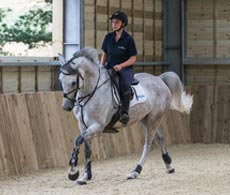
Four ways to spice up your schooling
Do you find yourself going around in circles during schooling sessions, wishing you could be out on a hack instead? Our expert tips can help you break through that boredom barrier and make your exercises more exciting
If you’re performing the same schooling routines over and over again, you can start to feel as though you’re stuck in a rut. Thankfully, it’s an easy one to get out of, and there are plenty of exercises and challenges you can use to boost your motivation.
‘The main reason for feeling unmotivated during schooling is not having a clear aim,’ says dressage rider and trainer Samantha Fish. ‘And while you should approach each session with a goal in mind, you should also remember that schooling isn’t just for competitive riders; it has benefits for everyone – even those who only really enjoy hacking or fun rides.
‘For example, being able to manoeuvre your horse so that you can open and shut a gate, or stand patiently at a junction, or move over to allow a car to pass, are all valuable skills you’ll gain from your schooling sessions. It’ll also help to make your time spent riding outside of the arena more enjoyable and, just as importantly, it’s a great way to fine-tune your relationship with your horse.’
So how can you make sure you’re getting all of these things from your schooling? Samantha has four practical tips that can help:
1. Set goals
‘I find that if I have something to aim towards, such as a lesson with my trainer or a competition, it gives me a real sense of motivation,’ Samantha explains. ‘And even if you don’t compete, you should still be setting goals. Think broadly about what you’d like to achieve; perhaps you want your horse to stand patiently at the mounting block, or maybe you’d like to be able to move his hindquarters over when hacking out.
‘By having a goal at the start of your schooling session, and a plan as to how you’ll achieve it, you’ll immediately give yourself something to work towards and look forward to. Then, once you have an aim in mind, it can also help to divide your session into sections of 10 to 15 minutes, and have a clear idea of what you’d like to work on in each. Make sure to take short breaks between the sections and, before you know it, an hour will have flown by.’
2. Fine-tune your transitions
‘One exercise worth practising over and over again is transitions,’ Samantha stresses. ‘With every horse I ride – from youngsters to advanced dressage horses – I do countless transitions. It’s especially important to concentrate on halt to walk, walk to halt, walk to trot and trot to walk. Plus, it’s a good way of assessing if your horse is listening to your aids.
‘Choose specific points around the arena or schooling area where you want to perform a transition, and try to be as accurate as possible. Your aim should be to ensure your horse is responsive to the slightest of your aids – for example, a light squeeze of the leg for an upward transition, and a gentle ask on the reins for a downward transition. And the more you practise, the more responsive he’ll become.’
3. Practise leg yielding
‘Leg yielding is where your horse moves sideways while keeping his body straight, with only a slight bend in his ribcage around your inside leg,’ says Samantha. ‘I perform leg yield both on a circle and down the long side of the arena, but you can also do this while hacking along a straight road.
‘To start with, imagine you’re riding a straight line and have both hands and legs on equally. Then, when you want to go sideways to the left, lift your left rein slightly away from your horse’s neck to direct him, while your right leg nudges his side to ask him to go sideways. Your horse should cross his hind legs underneath his body.
‘Don’t be too obsessed with going sideways for too long initially – it’s forwards a few strides and then sideways for a few strides, and then forwards again. When you ask for forwards, you use both reins and both legs.’
4. Ride with friends
‘It might sound obvious, but just having someone else in the arena while you ride can inspire you. They may be able to offer advice on your technique, and seeing the way they approach schooling can spur you on to try their methods yourself,’ says Samantha. ‘If your horse is stabled on a livery yard, bounce ideas off other riders and also watch them in action – this can be an excellent way to build up your enthusiasm and motivation.
‘You could also offer to video each other so that you can see where you need to develop. Watching yourself and your horse on video, and seeing what your movements really look like, can be a fantastic way to help improve your riding.’



